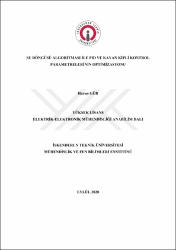| dc.contributor.advisor | Furat, Murat | |
| dc.contributor.author | Gür, Harun | |
| dc.date.accessioned | 2020-12-15T08:18:41Z | |
| dc.date.available | 2020-12-15T08:18:41Z | |
| dc.date.issued | 2020 | en_US |
| dc.date.submitted | 2020 | |
| dc.identifier.citation | Gür, H. (2020). Su döngüsü algoritması ile PID ve kayan kipli kontrol parametrelerinin optimizasyonu. (Yüksek Lisans Tezi). İskenderun Teknik Üniversitesi / Mühendislik ve Fen Bilimleri Enstitüsü, Hatay. | en_US |
| dc.identifier.uri | https://hdl.handle.net/20.500.12508/1502 | |
| dc.description.abstract | Endüstriyel alanda kontrol sistemleri, üretimin önemli unsurlarından biridir. Üretim sürecinin her adımında yapılan kontroller ile ürünün istenilen özelliklerde elde edilmesi sağlanır. Bunu sağlamak için gerekli şartlardan biri, seçilen kontrol sistem parametrelerinin uygun olmasıdır. Bu bağlamda, endüstriyel alanda PID kontrolcüsü, parametre sayısı ve uygulanan parametrelerin sisteme olan etkisinin gözlemlenebilmesinden dolayı en çok tercih edilen kontrolcülerdendir. Matematiksel modelleme ve açık-kapalı çevrim sistem cevaplarına dayalı yöntemler kullanılarak yapılan ayarlama yöntemleri literatürde mevcuttur. Bunula beraber, son yıllarda meta-sezgisel yöntemlerin de popüler olarak kullanıldığı görülmektedir. Ayrıca, PID için alternatif kontrol türü olan kayan kipli kontrol yöntemi de literatürde gerçek sistemler için önerilen bir kontrolcü türüdür. Her iki kontrol türü, gerçek sistemlerde iyi ayarlandığı takdirde yeterli düzeyde istenen çıkışı verebilmektedir. Ancak, her kontrol edilen sistemin yapısına uygun bir ayarlama yöntemi bulunmamaktadır. Son yıllarda bu sorunu aşmak için önerilen ayarlama yöntemi meta-sezgisel arama yöntemidir. Meta-sezgisel yöntemler, doğadaki çeşitli olaylardan esinlenilerek hazırlanan optimizasyon yöntemleridir. Bu yöntemlerin en önemli özelliği sürü tabanlı arama algoritmaları olup kontrol sisteminin matematiksel modellemesine ihtiyaç duymamasıdır. Bu yönü ile karmaşık kontrol sistemlerinin optimizasyonunda iyi sonuçlar verebilmektedir. Bu çalışmada meta sezgisel yöntemlerden bir olan Su Döngüsü Algoritması PID ve kayan kipli kontrol parametrelerinin ayarlanması için seçilmiştir. Seçilen sadece bir uygunluk fonksiyonuna dayalı bu algoritmalar ile bu fonksiyonu minimum yapacak parametreler aranır. Literatürde hataya bağlı performans fonksiyonlarından bir tane ya da birkaçının beraber kullanılması ile farklı arama uzayları içinde optimum parametreler aranır. Kontrol parametrelerinin her birinin farklı özellikler göstermesinden dolayı bu çalışmada özelleştirilmiş uygunluk fonksiyonları önerilmiştir. Böylece optimum parametrelerin bulunmasında hızlı sonuç alınmıştır. Elde edilen sonuçlar hem grafiksel hem de istatistiksel olarak sunulmuştur. | en_US |
| dc.description.abstract | Control systems in the industrial field are one of the important elements of production. With the controls performed at every step of the production process, it is ensured that the product is obtained with the desired properties. One of the necessary conditions to achieve this is that the selected control system parameters are appropriate. In this context, the PID controller is one of the most preferred controllers in the industrial field due to the fact that the number of parameters and the effect of the applied parameters on the system can be observed. Tuning methods using mathematical modeling and the methods based on open and closed loop system responses are available in the literature. However, it is seen that meta-heuristic methods are also used popularly in recent years. In addition, the sliding mode control method, which is an alternative controller for PID, is a type of controller suggested for real systems in the literature. Using both of the controllers, sufficient level of desired output can be obtained if well-tuned in real systems. However, there is no tuning method suitable for the structure of every controlled system. In recent years, the suggested tuning methods to overcome this problem are the meta-heuristic search algorithms. Meta-heuristic algorithms are optimization methods inspired by various events in nature. The most important feature of these algorithms is population-based search algorithms and the mathematical model of the controlled system is not needed. With this aspect, it can give good results in the optimization of complex control systems. In this study, Water Cycle Algorithm, which is one of the new meta-heuristic methods, was chosen to find optimum parameters PID and sliding mode controller. With these algorithms based on a single selected fitness function, the parameters that will make the function minimum are searched. In the literature, by using one or more of the error-based performance functions together, optimum parameters are searched in different search spaces. Since each of the control parameters shows different properties, customized fitness functions are proposed in this study. Thus, results were obtained fast in finding the optimum parameters. The obtained results are presented both graphically and statistically. | en_US |
| dc.language.iso | tur | en_US |
| dc.publisher | İskenderun Teknik Üniversitesi / Mühendislik ve Fen Bilimleri Enstitüsü / Elektrik-Elektronik Mühendisliği Anabilim Dalı | en_US |
| dc.rights | info:eu-repo/semantics/openAccess | en_US |
| dc.subject | Kayan kipli kontrol | en_US |
| dc.subject | Su döngüsü algoritması | en_US |
| dc.subject | Meta sezgisel algoritma | en_US |
| dc.subject | Optimizasyon | en_US |
| dc.subject | PID | en_US |
| dc.subject | Uygunluk fonksiyonu | en_US |
| dc.subject | Slide mode control | en_US |
| dc.subject | Water cycle algorithm | en_US |
| dc.subject | Meta heuristic optimization | en_US |
| dc.subject | Optimization | en_US |
| dc.subject | PID | en_US |
| dc.subject | Fitness function | en_US |
| dc.title | Su döngüsü algoritması ile PID ve kayan kipli kontrol parametrelerinin optimizasyonu | en_US |
| dc.title.alternative | Optimization of PID and sliding mode control parameters with water cycle algorithm | en_US |
| dc.type | masterThesis | en_US |
| dc.contributor.department | Mühendislik ve Fen Bilimleri Enstitüsü | en_US |
| dc.relation.publicationcategory | Tez | en_US |
| dc.contributor.isteauthor | Furat, Murat | |
| dc.relation.index | İndeks Bilgisi Yok | en_US |
















